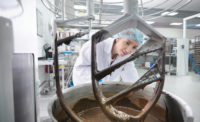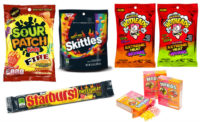Choice. As a consumer strolls down each isle at the grocery market, he or she find themselves surrounded by a plethora of choices and brands all vying for a chance to get in their cart. Yet with such an overwhelming amount of items to choose from, there is only one inevitable result – people become selective.
Although most are familiar with Chaucer’s concept that familiarity breeds contempt, English playwright Noël Coward remarked that “without a little familiarity it’s impossible to breed anything.” Perhaps there is no better quote to describe the past year in confections, as manufacturers continue to expand their operations, but with an extra degree of tentative selectivity.
That’s what can be gleaned from the Candy Industry’s Confectionery Equipment & Ingredient Survey for 2018. Over the course of the next three years, companies who were polled indicated they would purchase packing materials, ancillary equipment, and/or chocolate and confectionery processing equipment – trends that have not altered drastically since last year’s poll.
Refining what is currently available has been the objective. Over the past twelve months, over 50 percent of the companies surveyed have developed five products or less – but with expectations of launching five new products within the coming year. Crunching the survey numbers produced a mean of 25 products
Closer scrutiny reveals logistical equipment purchases rose five percent from the previous year, while primary packaging equipment dropped 18 percent. Nearly fifty-three percent of the companies expressed their intent to purchase melting and tempering machines for chocolate production, but the news wasn’t that good for other equipment categories. They all suffered a significant drop since the previous year.
Normal processing equipment is also down, with slightly more than a quarter of companies expressing a need for mixers and cutters. On the non-chocolate processing equipment end, one-third of surveyed companies said they would buy kettles, while just under a fourth also plan to purchase cookers.
Nearly 80 percent passed on acquiring cocoa processing equipment, but those who were interested were looking at obtaining refiners, ball mills, and conches – at 14, 12, and 12 percent respectively.
Of the 86 percent of those expressing their interest in ancillary equipment, a vast majority will buy moulds – at 61 percent. Scales and checkweighers come in at a close second at 59 percent, the increased demand for these products indicating an expansion of production facilities for existing goods.
Packaging material and equipment still remain as burgeoning sectors, as anticipated, with 43 and 53 percent indicating that they would purchase both primary and secondary packaging devices.
Form/fill/seal and twist wrappers have drawn the most interest in packaging over the past year, both at 22 percent respectively. Secondary packaging has been seeing marketable growth, with labelers at 37 percent and shrink wrappers a few steps behind at 33 percent. Regarding packaging materials, without much surprise, boxes, bags, and films occupy the top three – at 84, 76 and 49 percent.
While packaging still dominates the highest planned purchasing category, there still remains an impressive 51 percent allocated to logistics equipment. Software still remains the largest reported segment at 29 percent, as well as 27 percent toward renewed warehouses/order fulfillment.
Manufacturers still have strong investments plans for this year, with more than half saying they would increase spending on processing equipment. Slightly less than half (49 percent) agreed that there would be an increase in packaging equipment. The only category that shows only slight spending increases is logistics equipment, with 35 percent saying they would increase spending. Sixty percent said there would be no significant spending uptick.
In 2017, equipment investments made up 22 percent of capital expenditures from those surveyed. Additionally, 51 percent also indicated that they anticipated an increase in equipment spending in 2018. The predicted expenditure for equipment in the coming year averages to around $47,601.
It doesn’t come at a shock that cost savings/efficiency ranks as the driving motivator for equipment purchases at 84 percent. Both the reputation of the manufacturer/distributor as well as the intent to be used in current products also proved influential as reasons for buying.
The lower cost of total equipment expenditures comes partly due to a lack of expansion of production facilities, with only 35 percent having announced the addition of any new production lines to their factories.
When it comes to ingredients, 54 percent of companies only have one to two employees involved in purchasing decisions — and going by the mean of both data charts — just about as many people are involved in equipment purchasing discussions.
Availability yet again is the highest determinant factor for buyers when it comes to ingredient purchases — at 91 percent. That is shortly followed up by use in current products at 83 percent and reputation of manufacturer/distributor at 80 percent.
As the data indicates, the primary source of information about ingredients, at 78 percent, was gathered from Google searches. This trumps trade shows from 2016’s statistics, which were bumped down to third at 69 percent. Interestingly, trade magazines outperformed trade shows, coming in second as a resource at 74 percent.
It’s likely that ingredients spending will bump up again this coming year, fueled by the volatility in commodity pricing as well as new product development. As mentioned earlier, the predicted means comes to 25 new product launches annually — nearly double what was produced last year. Boring deeper, 63 percent of the businesses noted they will increase their spending on ingredients slightly this year. Capital expenditures for ingredients rounded out at around 38 percent.
In what’s seen as a sign of the times, 4 in 5 companies (81 percent) plan on allocating more money to purchase new ingredients for use in new products in 2018, surpassing spending for existing products, which sits at 70 percent. Meanwhile, ingredients currently being used in new products and substitute ingredients for existing products sit just below fifty percent each.
Last year, milk and dark chocolate were on an even keel – hovering just above 50 percent – but in 2017 dark chocolate had risen further in popularity. This year it is the highest chocolate expenditure at 70 percent, followed by cocoa powder at 67 percent, and milk chocolate at 61 percent.
Among healthy/nutritional ingredients, nuts and fruits still remain the biggest spending items at 76 and 56 percent, respectively. Seeds spending has also risen 11 points from the year prior, tying at 56 percent with fruits – indicating the continuing trend of growing demand for healthier items and food products.
Another shift from 2016 is the rise of natural/exempt color ingredients, dominating at 61 percent, while dyes and lakes have otherwise fallen toward a modest 28 percent. The same skew towards natural substitutes can be seen in flavoring ingredients, where vanilla and natural flavors still top out at 80 and 76 percent, respectively. Chocolate flavoring has rolled up to third at 56 percent, leaving both artificial and essential oils down at 41 percent.
In fats and oils, both cocoa butter and coconut are the preferred additives – matching up at 57 percent. Sugar, naturally, remains the indomitable sweetener of choice at 85 percent, the second place at 48 percent are natural sweeteners.
Other data worthy of note would include:
- 22 percent of surveyed companies on average include nuts as part of their operations
- There is no significant indication of increased usage of nuts in products into the coming year
- On the rise from last year’s data, 37 percent of companies have facilities wholly committed to using healthy and functional ingredients
- Just under half (49 percent) of companies anticipate an increase of heathy ingredient usage, while another 49 percent expect no noticeable change.
While there hasn’t been any momentous growth over the course of this year, stability remains a welcomed forecast for large and small manufacturers.









